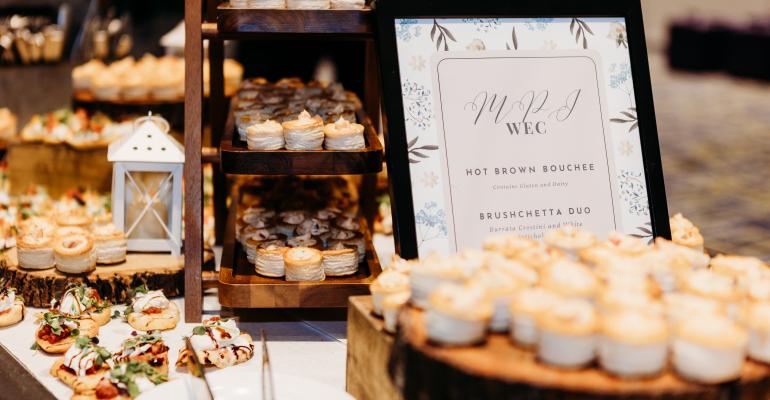Lesson learned: Interviewing a meeting planner while her conference is going on around her is practically inviting interruptions. However, it’s also a chance to see the multitasking superpowers planners are known for and to feel some of the event’s behind-the-scenes energy.
All of that came through during a conversation with Tanya Philyaw, CMP, senior meeting planner for Meeting Professionals International, during the recent World Education Congress in Louisville, Ky.
Philyaw sat down with MeetingsNet to talk about food and beverage for the show. She’s responsible for planning two lunches and three or four breaks for the conference, which draws about 2,000 business event planners and industry suppliers.
Guarantees: Fighting the Trend
Attendees are registering for conferences later and later (as Maritz research recently documented) and MPI is not immune. Revealing both a dry sense of humor and some exasperation, Philyaw says her out-of-office message before the conference reads: “Thank you for your email. Hope to see you WEC. If you're reading this, I'm sure you've already registered. If you haven't registered, I'm going to find you on site and talk to you about how guarantees work.”
Unfortunately, today’s trend of slow-to-commit attendees doesn’t alter the fact that venues expect their F&B guarantees 10 days out. Therefore, Philyaw relies heavily on knowing the show’s history.
Her pacing system gives her visibility into where registrations stand against previous years, and experience has taught not to guarantee full numbers. “So, if we have 2,000 attendees,” she says, “on my first day, historically, we have fed about 90 percent. On the second day, which includes lunch, we're typically down to around 75 percent. And then on the third day. it's about 65 percent.”
Menus in the Event App: Pros and Cons
MPI publishes its menus in the WEC conference app, allowing attendees a before-the-show look at what’s planned. “It's a good thing and a bad thing. The good thing is everybody knows what we're eating; the bad thing is everybody knows what we're eating,” quips Philyaw.
The upside is that attendees with dietary restrictions can see if there’s something on the menu for them. “Typically, about 30 percent of our attendees note some sort of dietary restriction, whether it’s as simple as, ‘I'm allergic to Brussels sprouts’ (which may not even be on the menu) or that they’re gluten-free, dairy-free, vegan, vegetarian, or need some other special meal.”
The downside is that people may shy away from unfamiliar foods. One of WEC’s all-attendee luncheons at WEC was Mediterranean-themed, with falafel, lamb meatballs, tabbouleh salad, grilled harissa yogurt chicken, and a variety of other dishes for both vegetarians and meat eaters. She didn’t have the official numbers back from Levy, which manages food operations at Louisville’s Kentucky International Convention Center, but her sense was that they fed somewhat fewer attendees than expected. There may be a lesson, she says: “If I'm going to be a little bit more creative [with the menu], I need to plan for a little more wash that day.”
Here's What I Have to Spend. What Can We Do?
Like most planners, Philyaw has felt the effect of inflation on food prices. Her strategy for putting together a workable menu relies both on being realistic and playing to the chefs’ strengths. “The very first time I meet the catering staff, I ask for their menus. I need to see what they normally charge. I am not going to ask for a $20 breakfast if I know that breakfasts are normally $42.”
After that, she delineates her needs, estimates a per-function spend, and then turns it over to the foodservice team, urging them to come back to her with recommendations based on what they do well.
“I want to know what they’re really good at,” says Philyaw. “When the chef decided he want to be a chef, why was that? Was it his mother's chicken? Does he get excited about pastry? Whatever it is that makes him your executive chef is what I want to see. I really let the venue bring things to me.”
Steady Energy Wins the Day
While Philyaw is happy indulge an attendee’s sweet tooth—noted by some fun, nostalgic items on the menu, such as homemade twinkies for an afternoon treat and homemade Pop Tarts for a morning break—she knows that the menu must be designed to keep attendees and staff on an even keel.
She is especially conscious of providing meals for the MPI staff that will deliver a steady source of energy through the day. “There are two or three staple menus that I bring in,” she says. “We have edamame, clean proteins, boiled eggs, those kinds of things. Some people love it, but I have some who ask, ‘Why am I having this for breakfast?’”





